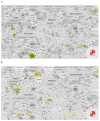Exome-Wide Association Study Reveals Host Genetic Variants Likely Associated with the Severity of COVID-19 in Patients of European Ancestry
- PMID: 36143338
- PMCID: PMC9504138
- DOI: 10.3390/life12091300
Exome-Wide Association Study Reveals Host Genetic Variants Likely Associated with the Severity of COVID-19 in Patients of European Ancestry
Abstract
Host genetic variability plays a pivotal role in modulating COVID-19 clinical outcomes. Despite the functional relevance of protein-coding regions, rare variants located here are less likely to completely explain the considerable numbers of acutely affected COVID-19 patients worldwide. Using an exome-wide association approach, with individuals of European descent, we sought to identify common coding variants linked with variation in COVID-19 severity. Herein, cohort 1 compared non-hospitalized (controls) and hospitalized (cases) individuals, and in cohort 2, hospitalized subjects requiring respiratory support (cases) were compared to those not requiring it (controls). 229 and 111 variants differed significantly between cases and controls in cohorts 1 and 2, respectively. This included FBXO34, CNTN2, and TMCC2 previously linked with COVID-19 severity using association studies. Overall, we report SNPs in 26 known and 12 novel candidate genes with strong molecular evidence implicating them in the pathophysiology of life-threatening COVID-19 and post-recovery sequelae. Of these few notable known genes include, HLA-DQB1, AHSG, ALOX5AP, MUC5AC, SMPD1, SPG7, SPEG,GAS6, and SERPINA12. These results enhance our understanding of the pathomechanisms underlying the COVID-19 clinical spectrum and may be exploited to prioritize biomarkers for predicting disease severity, as well as to improve treatment strategies in individuals of European ancestry.
Keywords: COVID-19 host genetics; common genetic variants; exome-wide association study for COVID-19 patients; genetic variation in COVID-19 patients.
Conflict of interest statement
The authors declare no conflict of interest.
Figures



Similar articles
-
Genomic and Ancestral Variation Underlies the Severity of COVID-19 Clinical Manifestation in Individuals of European Descent.Life (Basel). 2021 Sep 5;11(9):921. doi: 10.3390/life11090921. Life (Basel). 2021. PMID: 34575070 Free PMC article.
-
Analysis of potential protein-modifying variants in 9000 endometriosis patients and 150000 controls of European ancestry.Sci Rep. 2017 Sep 12;7(1):11380. doi: 10.1038/s41598-017-10440-9. Sci Rep. 2017. PMID: 28900119 Free PMC article.
-
Molecular genetic etiology by whole exome sequence analysis in cases with familial type 1 diabetes mellitus without HLA haplotype predisposition or incomplete predisposition.J Pediatr Endocrinol Metab. 2022 Nov 7;36(1):64-73. doi: 10.1515/jpem-2022-0295. Print 2023 Jan 27. J Pediatr Endocrinol Metab. 2022. PMID: 36343308
-
Targeted massively parallel sequencing of autism spectrum disorder-associated genes in a case control cohort reveals rare loss-of-function risk variants.Mol Autism. 2015 Jul 7;6:43. doi: 10.1186/s13229-015-0034-z. eCollection 2015. Mol Autism. 2015. PMID: 26185613 Free PMC article.
-
Spontaneous preterm birth: advances toward the discovery of genetic predisposition.Am J Obstet Gynecol. 2018 Mar;218(3):294-314.e2. doi: 10.1016/j.ajog.2017.12.009. Epub 2017 Dec 14. Am J Obstet Gynecol. 2018. PMID: 29248470 Free PMC article. Review.
Cited by
-
The peptidoglycan of Borrelia burgdorferi can persist in discrete tissues and cause systemic responses consistent with chronic illness.Sci Transl Med. 2025 Apr 23;17(795):eadr2955. doi: 10.1126/scitranslmed.adr2955. Epub 2025 Apr 23. Sci Transl Med. 2025. PMID: 40267217 Free PMC article.
-
COVID-19 Prevention and Treatment.Life (Basel). 2023 Mar 20;13(3):834. doi: 10.3390/life13030834. Life (Basel). 2023. PMID: 36983989 Free PMC article.
-
COVID-19 progression towards ARDS: a genome wide study reveals host factors underlying critical COVID-19.Genomics Inform. 2023 Jun;21(2):e16. doi: 10.5808/gi.22080. Epub 2023 Jun 30. Genomics Inform. 2023. PMID: 37415451 Free PMC article.
-
Human genetic determinants of COVID-19 in Brazil: challenges and future plans.Genet Mol Biol. 2024 Jan 15;46(3 Suppl 1):e20230128. doi: 10.1590/1678-4685-GMB-2023-0128. eCollection 2024. Genet Mol Biol. 2024. PMID: 38226654 Free PMC article.
References
-
- Driggin E., Madhavan M.V., Bikdeli B., Chuich T., Laracy J., Biondi-Zoccai G., Brown T.S., Der Nigoghossian C., Zidar D.A., Haythe J., et al. Cardiovascular Considerations for Patients, Health Care Workers, and Health Systems During the COVID-19 Pandemic. J. Am. Coll. Cardiol. 2020;75:2352–2371. doi: 10.1016/j.jacc.2020.03.031. - DOI - PMC - PubMed
Grants and funding
LinkOut - more resources
Full Text Sources
Research Materials
Miscellaneous

